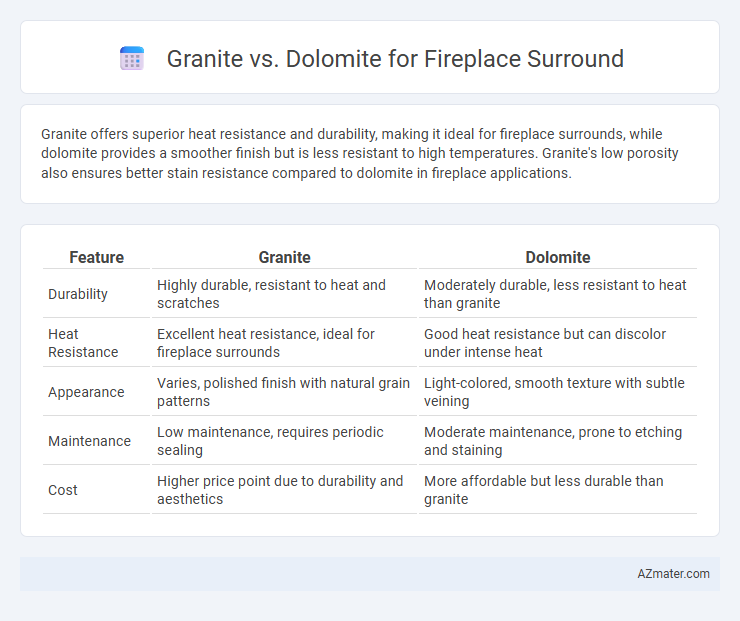Granite offers superior heat resistance and durability, making it ideal for fireplace surrounds, while dolomite provides a smoother finish but is less resistant to high temperatures. Granite's low porosity also ensures better stain resistance compared to dolomite in fireplace applications.
Table of Comparison
| Feature | Granite | Dolomite |
|---|---|---|
| Durability | Highly durable, resistant to heat and scratches | Moderately durable, less resistant to heat than granite |
| Heat Resistance | Excellent heat resistance, ideal for fireplace surrounds | Good heat resistance but can discolor under intense heat |
| Appearance | Varies, polished finish with natural grain patterns | Light-colored, smooth texture with subtle veining |
| Maintenance | Low maintenance, requires periodic sealing | Moderate maintenance, prone to etching and staining |
| Cost | Higher price point due to durability and aesthetics | More affordable but less durable than granite |
Introduction to Granite and Dolomite Fireplace Surrounds
Granite and dolomite are both popular choices for fireplace surrounds due to their durability and aesthetic appeal. Granite is an igneous rock known for its hardness, resistance to heat, and wide variety of colors and patterns, making it ideal for high-heat areas like fireplaces. Dolomite, a sedimentary carbonate rock, offers a unique crystalline texture and moderate heat resistance, often preferred for its elegant appearance and slightly softer, workable surface compared to granite.
Key Differences Between Granite and Dolomite
Granite consists primarily of quartz and feldspar, offering superior hardness and heat resistance compared to dolomite, which is mainly composed of calcium magnesium carbonate and tends to be softer and more prone to etching. Granite's dense, non-porous structure provides enhanced durability and stain resistance, ideal for high-heat environments like fireplace surrounds, while dolomite's lighter colors and crystalline texture offer aesthetic appeal but require more maintenance. The key differences in mineral composition, durability, and heat tolerance make granite a more practical choice for fireplace surrounds, whereas dolomite suits decorative applications with less direct exposure to heat and wear.
Aesthetic Appeal: Granite vs Dolomite
Granite offers a wide range of rich, natural patterns and colors, providing a luxurious and timeless look for fireplace surrounds with its coarse-grained texture and unique veining. Dolomite delivers a more subtle and muted appearance, featuring soft, earthy tones and smooth surfaces that create an elegant and understated ambiance. Both materials enhance aesthetic appeal but cater to different design preferences--granite suits bold, dramatic settings while dolomite complements minimalist, classic interiors.
Durability and Heat Resistance Comparison
Granite and dolomite both offer robust durability for fireplace surrounds, with granite being notably harder and more resistant to scratches and chipping due to its high quartz content. In terms of heat resistance, granite withstands high temperatures without discoloration or damage, making it an ideal choice for direct fireplace exposure, while dolomite, composed mainly of calcium magnesium carbonate, demonstrates good heat resistance but is more prone to thermal stress and potential cracking. Choosing granite ensures superior longevity and reliable performance under continuous heat exposure compared to dolomite.
Maintenance Requirements for Granite and Dolomite
Granite fireplace surrounds require minimal maintenance due to their dense, non-porous surface, making them resistant to stains and heat damage; regular sealing every 1-2 years enhances durability. Dolomite, while also sturdy, demands more frequent sealing and careful cleaning to prevent etching and discoloration from acidic substances. Both materials benefit from gentle cleaning with pH-neutral products to preserve their appearance and longevity.
Cost Considerations: Granite vs Dolomite
Granite typically costs between $50 to $100 per square foot, offering a durable and heat-resistant option for fireplace surrounds, while dolomite ranges from $40 to $80 per square foot, making it a more budget-friendly choice with similar aesthetic appeal. Installation costs for both materials are comparable, though granite's higher density may increase labor expenses slightly. Granite's longer lifespan and resistance to heat-induced cracking can provide better value over time despite the initial higher investment.
Installation Process and Challenges
Granite offers a straightforward installation process for fireplace surrounds due to its uniform hardness and availability in large slabs, allowing precise cuts and fitting with standard masonry tools. Dolomite, being a bit softer and more porous, requires careful handling and sealing during installation to prevent damage and staining, presenting challenges in ensuring long-term durability. Both materials demand skilled labor, but granite's robustness typically results in fewer installation complications compared to the more delicate nature of dolomite.
Pros and Cons of Granite Fireplace Surrounds
Granite fireplace surrounds offer exceptional durability and heat resistance, making them ideal for long-lasting, high-use fireplaces. Their natural variation in color and pattern provides unique aesthetic appeal, though they can be more expensive and require professional installation due to their weight and hardness. Granite is non-porous compared to other stones, reducing the risk of staining, but its cold surface may feel less inviting in cozy living spaces.
Pros and Cons of Dolomite Fireplace Surrounds
Dolomite fireplace surrounds offer a unique aesthetic with their subtle veining and lighter tones, providing a sophisticated and elegant look that blends well with various interior styles. Dolomite is relatively durable and heat-resistant, making it functional for fireplaces, but it is softer than granite and more prone to scratching and chipping over time. While it is often more affordable than granite, dolomite requires regular maintenance and sealing to preserve its appearance and prevent stains.
Choosing the Best Material for Your Fireplace Surround
Granite offers exceptional durability and heat resistance, making it a reliable choice for fireplace surrounds that require long-lasting performance and low maintenance. Dolomite, with its unique crystalline structure, provides a more decorative and visually appealing option but may be slightly less resistant to heat and wear compared to granite. When choosing the best material for your fireplace surround, consider your priorities in terms of aesthetic appeal, durability, and budget to ensure the perfect balance for your living space.

Infographic: Granite vs Dolomite for Fireplace Surround
 azmater.com
azmater.com